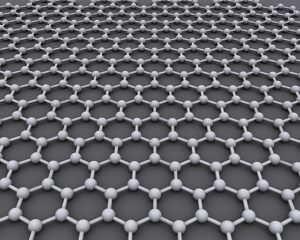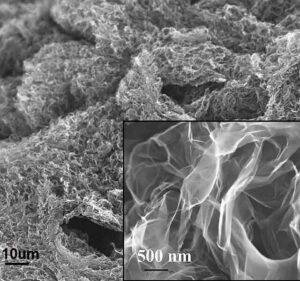Graphene is twenty years old now. Discovered by Andre Geim and Konstantin Novoselov, two physicists at the University of Manchester. The Conversation hailed this anniversary in a piece by Stephen Lyth on its achievements and their shortcomings. So far, graphene didn’t fulfil all it’s promises. Maybe in the future?

Graphene is a crystalline form of carbon; equivalent to a single layer of graphite, just one atom thick. The claims are fabulous. Graphene is supposed to be stronger than steel, highly flexible, super-slippery and impermeable to gases. A better electronic conductor than copper, and a better thermal conductor than diamond. Practically invisible, and displaying a host of exotic quantum properties. Graphene is extremely lightweight and chemically inert, and flexible with a large surface area. It is also considered eco-friendly and sustainable, with unlimited possibilities for numerous applications.
Strongest material
Graphene has the potential to create the next-generation of electronics. Faster transistors, semiconductors and bendable phones. It can be used as a coating to improve touch screens for phones and tablets. And to make very fast computers. This supercomputing power might be used widely across the chemical industry – from drug design to modelling; and even in the stock markets for financial analysis. Even with some defects, graphene is the strongest material in the world.
There are also more futuristic claims. Like space elevators. These involve a tether – a very long ladder – that could be lowered from a satellite to the surface of the Earth. Astronauts could then climb up the tether into space. Or graphene could be used for solar sails. Spacecraft fitted with these will not need fuel as a propellant; therefore they can be much lighter, and easier to launch. Quite another application is the use in artificial retinas, that could help patients with degenerated photoreceptors. Some people even dream of using graphene in an invisibility cloak.
Expectations
Research into applications is going on, and fast. Nevertheless, some people are disappointed. Shortly after the discovery of graphene, expectations were sky-high. Just six years after their discovery, Geim and Novoselov were awarded the Nobel Prize in Physics, and this further fuelled the enthusiasm around this wonder stuff.
But as often, expectations were too high. Graphene couldn’t fulfil all promises. What happened in reality: there was a steady flow of articles, and a steady integration of graphene into numerous practical applications. Much of this is thanks to the Graphene Flagship – a major European research initiative coordinated by Chalmers University of Technology in Sweden. More than 90 products have been developed over the past decade as a result.

Lighter, more flexible, safer
For instance, blended plastics containing graphene were used in high-performance sports equipment like tennis rackets. Graphene was incorporated in a ‘next-generation amorphous (non-crystalline) spherical silica’, a rubber that is able to deliver the holy grail of low rolling resistance, improved grip in the dry and wet and long-term durability. It was also used to create a new motorcycle helmet. It has a graphene coating that allows better distribution of impact forces. This makes the helmet safer and more comfortable. Also developed: thermally conductive coatings for motorcycle components, and lubricants for reducing friction and wear between mechanical parts.
What’s next? Batteries might much improve from graphene. They can be lighter and more flexible, faster charging and with higher capacity, and have a higher temperature range. Graphene may also be used in supercapacitors, devices that store electricity. They have some disadvantages to batteries (lower energy storage); but they can charge and discharge much faster than batteries. They do not suffer the same wear and tear as a battery and can therefore survive hundreds of thousands more charge and discharge cycles.
More applications
And then there are conductive graphene inks. They are now used to manufacture sensors, and low-cost wireless tracking tags, that realize low-cost, environmentally friendly, and sustainable production. Printing using conductive inks based on graphene formulations opens many innovation opportunities in electronics, sensors, optical and heating systems. They also present solutions for monitoring chronic conditions such as diabetes. They can be used in electromagnetic shielding. This will guard electronics and cables against incoming or outgoing emissions of electromagnetic radiation. Graphene is even used in headphones to improve the sound quality. It’s key advantages lie in its ultralight and ultrathin nature, coupled with exceptional strength, making it a perfect fit for headphone diaphragms.
And then there is graphene oxide (GO) – a material with a somewhat mysterious structure. Nevertheless with useful applications. Like water desalination. A new start-up G2O Water offers a graphene-based water membrane technology; it can be applied to any filter medium used today, and reduce their energy costs of those filters by 80-90%. In wastewater treatment, GO has a number of advantages. Traditional methods have limitations in terms of efficiency, cost, or selectivity. One of the key advantages of GO is its large surface area, which provides a significant adsorption capacity. For similar reasons, GO membranes have exceptional potential in rejecting and separating contaminants from aqueous solutions. The abundant availability of oxygenated functional groups and the high surface area of GO make it an ideal choice for synthesizing composite membranes used in water purification.
Major corporations
And then, The Conversation mentions ongoing research. By major corporations including SpaceX, Tesla, Panasonic, Samsung, Sony and Apple. These are all rumoured or known to develop new products from graphene.
The promise of graphene as a material is still in full force. Even though there is little publicity about graphene’s successes. Once a material is embedded in a working product, there is little need to mention it. Moreover, there may be proprietary claims than would make companies reluctant to get into details. Nevertheless, graphene becomes ever more widely adopted. After twenty years, graphene’s successes are being celebrated quietly rather than with much blare of trumpets.
Interesting? Then also read:
Graphene in concrete
A transition that makes use of existing energy infrastructure
Respectful treatment of the complexity of biomass
